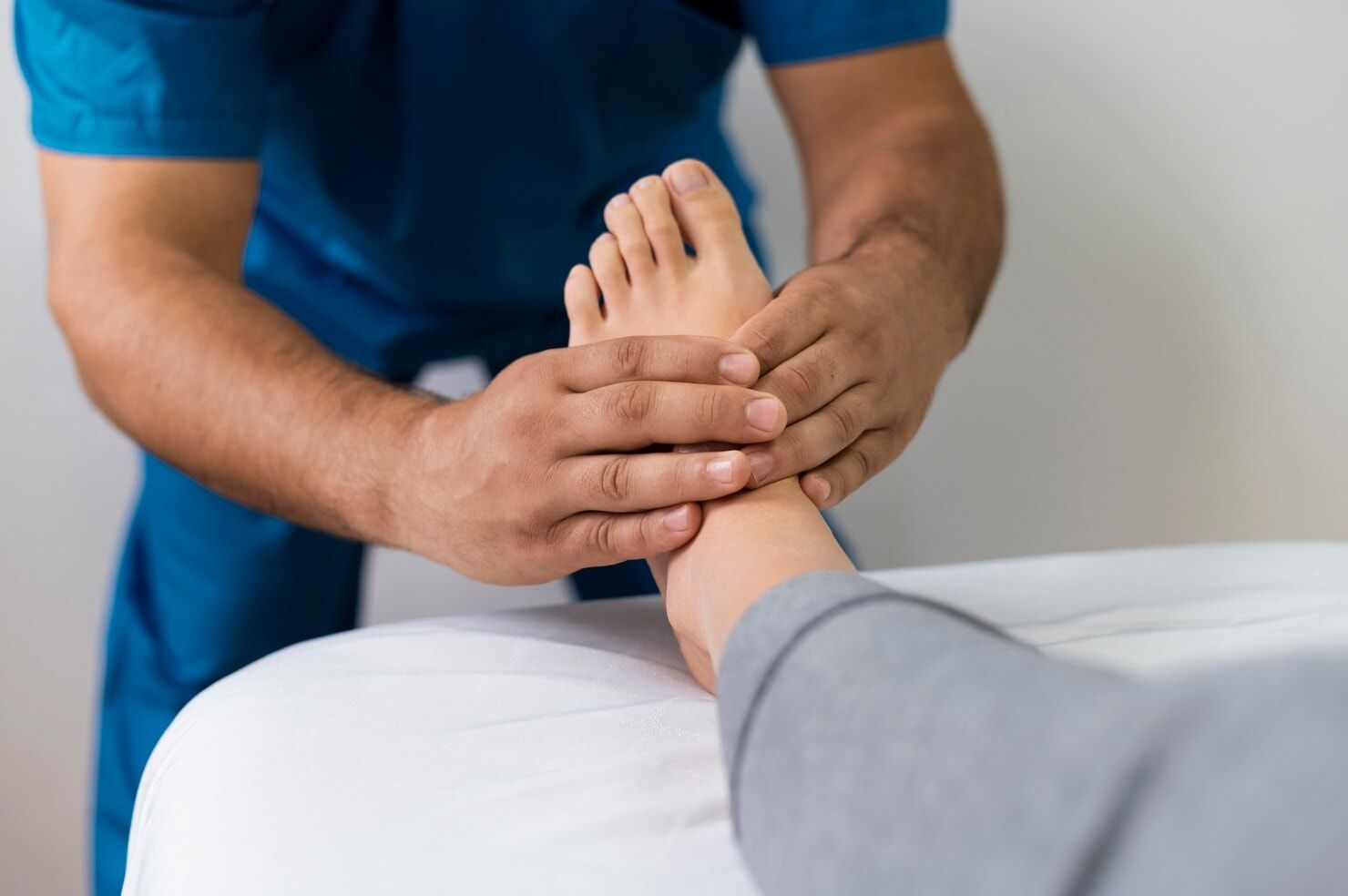Sudden Ankle Pain Without Injury: Causes and Treatment
By Nigel ChuaExperiencing ankle pain without injury can be worrying, especially if it comes out of nowhere. However, considering the ankle bears most of our weight, it's no surprise this body part is susceptible to various issues. Here, we'll explore the common causes of sudden ankle pain without injury and discuss effective treatment options. Understanding these factors can help you manage discomfort and take steps towards a healthier ankle.

Who Gets Ankle Pain Without Injuries?
People of all ages can get frequent ankle pain without injury, but it is more common among middle-aged and older adults. In Singapore, ankle pain is one of the common orthopaedic conditions, with one in four people experiencing some type of ankle and foot pain. As we age, our bone structures including the ankle joint and tendons can become more susceptible to wear and tear.
Those with fluctuating weight are also prone to sudden ankle pains. Changes in weight can strain the muscles in your feet and ankles or cause your feet to flatten or pronate excessively. This may consequently put strain on the ankle joint.
If you experience sudden ankle pain without the presence of trauma, a variety of reasons could be behind it. So essentially, it's not only a matter of age or weight but also underlying health conditions and lifestyle factors.
What Causes Sudden Ankle Pain Without Injury?

The ankle consists of a complex structure and network of bones, muscles, tendons, and ligaments. The joints help us move our feet up and down, and side to side. The muscles and tendons around the ankle make these movements possible, and the ligaments hold all the bones in place.
If you experience sudden ankle pain for no reason, there are numerous potential causes including pre-existing health conditions. Below are the most common findings.
1. Autoimmune Disease
Here, the body's immune system mistakenly attacks its own tissues, leading to inflammation and pain in various parts of the body, including the ankles. This inflammation can lead to swelling, redness, and pain. Over time, chronic inflammation can damage the joints, including the ankle joint.
Examples of autoimmune diseases that cause ankle pain without injury are as follows:
Rheumatoid Arthritis
Joint inflammation stemming from this chronic autoimmune disease leads to swelling, stiffness, pain, and eventual damage.
Lupus
A systemic autoimmune disease that can affect multiple organs, including the joints. Lupus can also lead to inflammation of the surrounding tissues, such as the tendons and ligaments.
Osteoarthritis
While not strictly an autoimmune disease, osteoarthritis can be exacerbated by underlying autoimmune conditions. Osteoarthritis is a degenerative joint disease characterised by the breakdown of cartilage, the cushioning tissue between bones.
Reactive Arthritis
A type of arthritis that often follows an infection, such as a sexually transmitted infection or a urinary tract infection.
Infectious Arthritis
This condition is caused by a direct infection of the joint, often due to bacteria or viruses. This can lead to joint pain, swelling, redness, and warmth.
Gout
This type of inflammatory arthritis happens when uric acid crystals build up in the joints. It commonly occurs in the big toe but can also affect the ankle and joints.
2. Foot Structure Issues
Foot structures like flat feet, irregular arches, and fallen arches can misalign the foot and ankle, putting extra stress on the joints and muscles.
For instance, having any of these conditions can lead to overpronation, which happens when the foot rolls inward excessively, putting pressure on the ankle joint. It can also cause muscle strain or fatigue, leading to pain. Additionally, the ligaments that support the ankle joint can become weak or stretched, increasing the risk of instability.
Those are not only the sole cause. Other factors, such as overuse, improper footwear, or underlying health conditions, are also influential.
3. Tendon and Joint Conditions
Several tendon and joint conditions can lead to ankle pain. For example, Achilles Tendinitis, a condition that occurs when the Achilles tendon becomes inflamed, can cause pain and stiffness in the heel bone.
Below are common tendon and joint conditions contributing to random ankle pain.
- Bursitis: Inflammation of the bursa, a fluid-filled sac that cushions the joints
- Tarsal Tunnel Syndrome: Similar to carpal tunnel syndrome, it involves compression of the tibial nerve in the ankle
- Sinus Tarsi Syndrome: Caused by inflammation of the sinus tarsi, a small bone cavity in the ankle
- Plantar Fasciitis: Inflammation of the plantar fascia, a tissue that connects the heel to the toes which is particularly painful in the morning
4. Systemic Diseases
Systemic diseases, which affect the entire body, can also contribute to ankle pain. For example:
- Scleroderma causes the body's tissues to become hardened and thickened, which can lead to pain and stiffness in the ankle joints.
- Osteochondral lesion of the talus involves damage to the cartilage and underlying bone in the talus, a bone in the ankle, limiting the range of motion.
- Post-tibial tendon dysfunction causes inflammation or degeneration of the posterior tibial tendon, which helps to support the arch of the foot, leading to instability in the ankle.
5. Infections
Bacterial or fungal infections can cause inflammation and pain in the ankle. These infections can be caused by injuries, surgery, or underlying health conditions.
6. Shoe-related issues
Wearing ill-fitting shoes or shoes that lack proper support can contribute to ankle pain. High heels, for example, can put extra stress on the ankle joint, leading to pain and discomfort. Additionally, shoes that are too tight or too loose can cause misalignment and instability in the foot and ankle.
Multiple factors can often contribute to ankle pain, so consulting a healthcare professional is essential for accurate diagnosis and treatment.
Diagnosing the Causes of Ankle Pain
Diagnosing the underlying cause of ankle pain often involves a combination of medical history, physical examination, and may call for additional tests.
Your doctor will likely ask about symptoms, such as when the pain started and if it worsens with activity. During this assessment, a doctor will determine if there's a presence of a traumatic or physical injury and ask you about any existing medical conditions.
Your doctor will examine your ankle for swelling, tenderness, range of motion, and stability. Additional tests may include:
- X-rays: To check for fractures, dislocations, or arthritis.
- MRI: To visualise the soft tissues of the ankle, including the tendons, ligaments, and cartilage.
- Ultrasound: To examine the tendons and ligaments in the ankle.
- Blood tests: To check for signs of infection, inflammation, or autoimmune diseases.
How to Treat Ankle Pain Without Injuries
Treatment for ankle pain without injury will depend on the identified cause. However, some common approaches include:
Over-the-counter Pain Medications
Pain and anti-inflammatory drugs can help reduce pain, inflammation, and fluid buildup or swelling for mild to moderate ankle pain without injury.
RICE (Rest, Ice, Compression, Elevation)
This approach is a common first-aid treatment for ankle pain, especially when caused by injuries like sprains or strains. Here's a general guideline of how this works:
- Rest: Avoid activities that aggravate the ankle pain.
- Ice: Ice the injured area for 15-20 minutes with 2-3 hour intervals to help with the swelling.
- Compression: Use an elastic bandage to wrap the ankle to provide some support.
- Elevation: Keep the ankle elevated above the heart whenever possible.
Exercise and Physical Therapy
Targeted exercises and physical therapy can help strengthen the ankle muscles, improve flexibility, and enhance overall ankle function.
How Physical Therapy Helps
Ankle pain physiotherapy helps treat sudden ankle pain without injury after the initial acute phase has subsided. It also involves management strategies similar to physiotherapy for ankle injury, improving mobility and function.
Skilled physical therapists from Phoenix Rehab in Singapore can develop a customised exercise program to strengthen the muscles around the ankle, improve flexibility, and restore range of motion. They can also guide on proper biomechanics and gait analysis to help prevent future injuries.
Physical therapy in managing ankle pain may include the following modalities:
- Manual therapy
- Ultrasound
- Electrical stimulation
- Strengthening exercises
- Balance exercises
A qualified physiotherapist will teach you the correct way to do exercises to prevent injuries and promote healing. They'll monitor your progress and modify your exercises as needed to optimise your recovery.
When to See a Doctor
If you experience persistent ankle pain, swelling, or limited range of motion, you may consult a physical therapist or healthcare professional. Early diagnosis and treatment can help prevent complications and walk comfortably again.
Conclusion
Sudden ankle pain without injury can be frustrating. If you have no clue what could be causing it, seek professional evaluation for accurate diagnosis. Similarly, if self-management does not work, follow appropriate treatment recommendations from a physical therapist to improve your ankle health.
Browse other articles by category
Physiotherapy for Knee Pain Physiotherapy For Slipped Disc Physiotherapy for Neck Pain PHYSIOTHERAPY
PHYSIOTHERAPY
 Hand Therapy
Hand Therapy
 Alternative
Alternative
 Massage
Massage
 Traditional Chinese Medicine Treatment
Traditional Chinese Medicine Treatment
 Rehab
Rehab
 Physiotherapy For Lower Back Pain
Physiotherapy For Shoulder Pain
Orthopedic Doctors, Insurance & Healthcare
Physiotherapy For Upper Back Pain
Frozen Shoulder
Physiotherapy for Back Pain
Physiotherapy For Lower Back Pain
Physiotherapy For Shoulder Pain
Orthopedic Doctors, Insurance & Healthcare
Physiotherapy For Upper Back Pain
Frozen Shoulder
Physiotherapy for Back Pain

 Whatsapp us now
Whatsapp us now